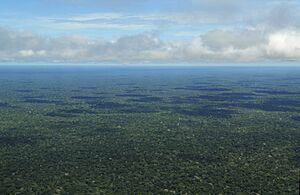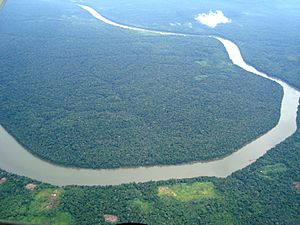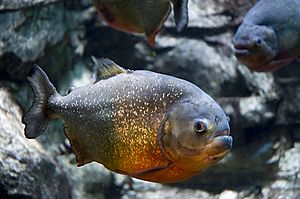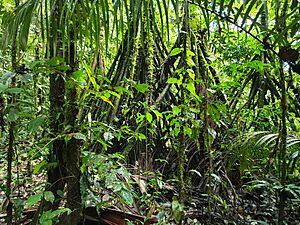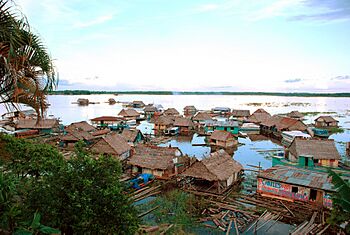Amazon basin facts for kids
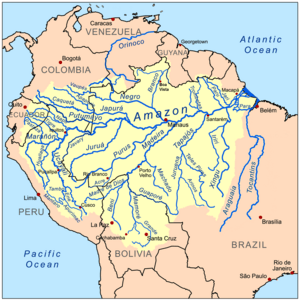
The Amazon basin is a huge area in South America. It is where all the water from the Amazon River and its smaller rivers (called tributaries) flows. This basin covers about 7 million square kilometers (2.7 million square miles). That's about 35.5% of the entire South American continent!
You can find parts of the Amazon basin in many countries. These include Bolivia, Brazil, Colombia, Ecuador, Guyana, Peru, Suriname, and Venezuela. It also includes the territory of French Guiana. Most of this large area is covered by the Amazon rainforest. This rainforest is also known as Amazonia. It is the biggest rainforest in the world. It covers about 5.5 million square kilometers (2.1 million square miles) with thick tropical forest.
Contents
Exploring the Amazon's Geography
The Amazon River starts high up in the Andes Mountains. These mountains are on the western side of the basin. Its main starting rivers are the Marañón River and Apurimac River in Peru. The highest point in the Amazon's watershed is Yerupajá mountain. This peak is 6,635 meters (21,768 feet) tall.
The Amazon River Basin stretches across the central and eastern parts of South America. It lies east of the Andes mountains. It goes from the Guyana Plateau in the north to the Brazilian Plateau in the south.
The Amazon River is about 6,400 kilometers (4,000 miles) long. It flows into the Atlantic Ocean. It is considered one of the two longest rivers in the world. Some scientists even think it's longer than the Nile River. But people still discuss its exact length.
The Amazon River system carries more water than any other river system. It moves about 20% of all the water that rivers carry to the oceans. Sadly, some parts of the Amazon rainforest are being cut down. This is happening because of more cattle farms and soybean fields. Long ago, the Amazon basin used to flow west towards the Pacific Ocean. But when the Andes mountains formed, the river changed direction. Now, it flows east towards the Atlantic Ocean.
The Amazon basin is divided into different political areas. These include Peruvian Amazonia, Amazônia Legal in Brazil, and the Amazon natural region in Colombia. It also includes Amazonas (Venezuelan state) and parts of Bolivia and Ecuador.
Amazing Plant Life
The plants in the Amazon grow very close together. There are also many different kinds of animals here. This is because of the heavy rainfall and the thick, green evergreen and coniferous forests. Not much sunlight reaches the ground. This is due to the dense roof of leaves from the tall trees. The ground stays dark and wet. Only plants that like shade can grow there.
Plants like Orchids and bromeliads grow on trees. They use the trees to get closer to the sunlight. They hang onto branches or tree trunks with aerial roots. They are not parasites, but epiphytes. Some tropical trees found in the Amazon include the Brazil nut tree, rubber tree, and Assai palm.
Incredible Wildlife
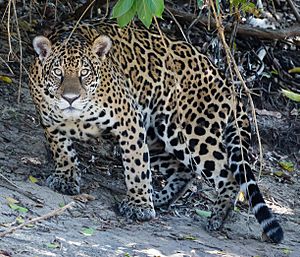
The Amazon basin is home to an amazing variety of animals.
Mammals of the Amazon
More than 1,400 different kinds of mammals live in the Amazon. Most of these are bats and rodents. Some of the larger mammals you might find are the jaguar, ocelot, capybara, puma, and South American tapir.
Birds of the Amazon
About 1,500 bird species live in the Amazon basin. The huge number of different bird species shows how rich the biodiversity is here. For example, the cotinga family, which includes the Guianan cock-of-the-rock, lives in these wet forests. Birds like toucans and hummingbirds are also found here.
Macaws are famous for gathering by the hundreds. They come to the clay cliffs along the Amazon River. In the western Amazon, hundreds of macaws and other parrots come down to exposed river banks. They eat clay almost every day, unless it's raining.
Reptiles of the Amazon
The green anaconda lives in the shallow waters of the Amazon. The emerald tree boa and boa constrictor live in the Amazonian treetops. Sadly, many reptile species are collected without permission. They are then sold in the international pet trade.
Amphibians of the Amazon
More than 1,500 species of amphibians live in the Amazon. Unlike frogs in cooler places, tropical frogs are mostly found in trees. Few are near water on the forest floor. This is because frogs need to keep their skin moist. Almost half of their breathing happens through their skin. The high humidity and frequent rainstorms in the rainforest give tropical frogs more freedom. They can move into the trees and escape many predators in the water.
Fish of the Amazon
About 2,500 fish species are known in the Amazon basin. Scientists think there are more than 1,000 other species that haven't been named yet. This is more than any other river basin on Earth! About 45% (over 1,000 species) of the known Amazonian fish are found nowhere else.
The Amazon supports very large fisheries. These include well-known species like large catfish and arapaima. It is also home to many species important for the aquarium trade. These include the oscar, discus, angelfish, and neon tetra. The Amazon basin also has some feared fish species. These include piranhas (like the famous red-bellied), electric eels, and river stingrays.
Some Amazonian fish can even live on land! The splash tetra lays its eggs on plants above water. It keeps them wet by splashing water on them. The South American lungfish can survive underground in a slimy cocoon during the dry season. Some small fish can jump over land between water sources. They might even jump onto land to escape predators in the water.
Amazon's Climate
The Amazon River basin has a low-water season, often called summer. It also has a wet season, known as winter. During the wet season, the rivers flood the nearby low-lying forests. The climate of the basin is usually hot and humid.
However, in some areas, the summer months (June–September) can bring cold snaps. These are caused by Antarctic winds traveling along the nearby mountains. The average yearly temperature is around 25 to 28 degrees Celsius (77 to 82 degrees Fahrenheit). There is little difference between summer and winter temperatures.
Human Life in the Amazon
Amazonia is not very populated. There are small settlements inland. But most people live in a few larger cities along the Amazon and other big rivers. Examples are Iquitos in Peru, and Manaus and Belém in Brazil.
In many areas, the forest has been cleared for soya bean plantations and ranching. Some people living there collect wild rubber latex and Brazilian nuts. This is a way of farming where trees are not cut down. These activities are more sustainable than cutting down the rainforest for wood or farming. The local people live in houses shaped like beehives with thatched roofs. They also build apartment-like houses called "Maloca" with steeply slanting roofs.
Languages Spoken in the Amazon
The most common languages spoken in the Amazon are Portuguese and Spanish. There are also hundreds of native languages still spoken in the Amazon. Most of these are critically endangered, meaning very few people still speak them.
Indigenous Peoples of the Amazon
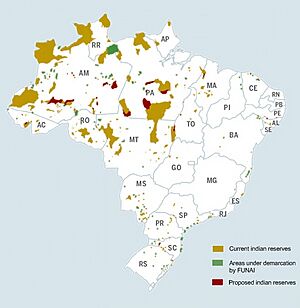
Many tribal groups live in the Amazon Basin. They often live in isolation. It is thought that 400 or more tribal groups have lived in the Amazon Basin for hundreds of years. They have their own cultures, languages, and ways of life. Today, the total population of the Amazon basin is 1.5 million people. There are an estimated 100 tribal groups that have not yet had contact with the outside world.
The largest group that works for the rights of indigenous peoples in this area is COICA. This is a big organization that includes all indigenous rights groups working in the Amazon basin. It helps people living in several countries.
River Transportation
The river is the main way to travel and move goods in these regions. People use everything from simple balsa rafts and dugout canoes to handmade wooden river boats and modern steel ships.
Farming in the Amazon
Seasonal floods bring rich soil onto beaches and islands. This allows farming of rice, beans, and corn along the river during the dry season. Farmers don't need to add fertilizer. People also use slash and burn farming on higher floodplains. Fishing provides extra food all year. Free-range chickens find most of their own food locally. Charcoal is made from dead trees and branches. It is used in cities for things like making steel. People also hunt bushmeat, especially deer and turtles.
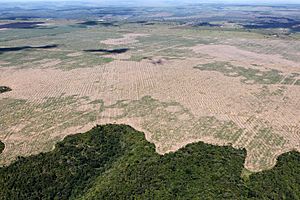
Widespread deforestation, especially in Brazil, is causing many known and unknown species to disappear. This reduces biological diversity. It also harms the soil, water, and air quality. A big part of deforestation is making charcoal for industries like steel making. The soils in the region are usually shallow. They cannot be used for more than a few seasons without adding fertilizers and chemicals from outside.
The Amazon's Role in Global Climate
The Amazon plays a very important role for the Earth's climate. Over the past 20 years (up to 2021), the Brazilian Amazon has released 13% more carbon dioxide (CO2) than it has absorbed.
The Amazon's amazing variety of life also helps global systems. It affects the global carbon cycle and climate change. It also influences weather patterns and rainfall in South America. The Amazon also produces 20% of the Earth's oxygen.
Images for kids
See Also
 In Spanish: Cuenca del Amazonas para niños
In Spanish: Cuenca del Amazonas para niños
- Amazon biome
- Amazon Cooperation Treaty Organization
- Amazon Conservation Association
- Amazon Conservation Team
- Deforestation of the Amazon rainforest
- Llanos de Moxos
- Llanos de Moxos (archaeology)
- Ucayali Peneplain
- Pre-Columbian agriculture in the Amazon Basin



